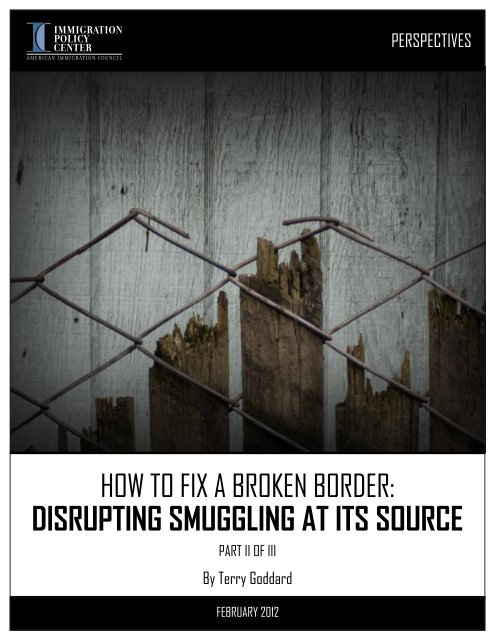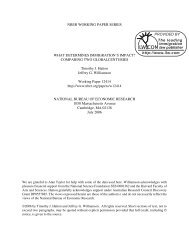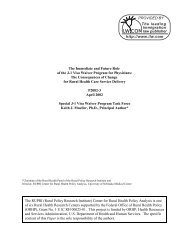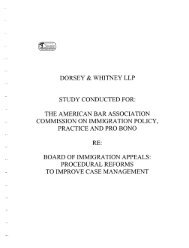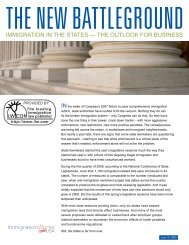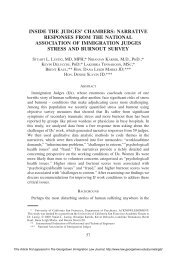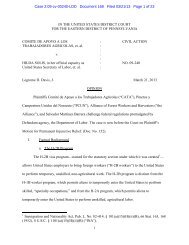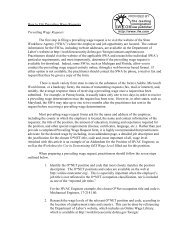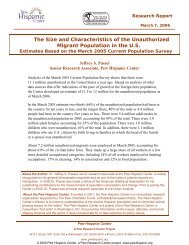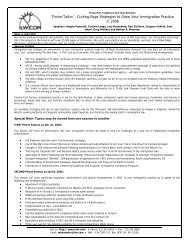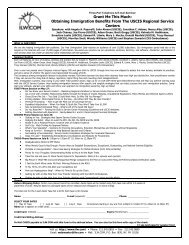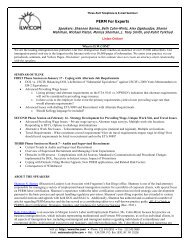Article: How To Fix A Broken Border - ILW.com
Article: How To Fix A Broken Border - ILW.com
Article: How To Fix A Broken Border - ILW.com
Create successful ePaper yourself
Turn your PDF publications into a flip-book with our unique Google optimized e-Paper software.
IMMIGRATION<br />
POLICY<br />
CENTER<br />
A M E R I C A N I M M I G R AT I O N CO U N C I L<br />
PERSPECTIVES<br />
HOW TO FIX A BROKEN BORDER:<br />
DISRUPTING SMUGGLING AT ITS SOURCE<br />
PART II OF III<br />
By Terry Goddard<br />
FEBRUARY 2012
HOW TO FIX A BROKEN BORDER:<br />
DISRUPTING SMUGGLING AT ITS SOURCE<br />
PART II OF III<br />
BY TERRY GODDARD<br />
FEBRUARY 2012<br />
ABOUT PERSPECTIVES ON IMMIGRATION<br />
The Immigration Policy Center’s Perspectives are thoughtful narratives written by leading academics and researchers<br />
who bring a wide range of multi‐disciplinary knowledge to the issue of immigration policy.<br />
ABOUT THE AUTHOR<br />
Terry Goddard <strong>com</strong>pleted his second and final term as Arizona’s Attorney General in January 2011 and has reentered<br />
the private practice of law. A native of Tucson, Arizona and graduate of Harvard College, he was first elected Arizona<br />
Attorney General in 2002. Over 8 years in office, he focused on protecting consumers and fighting the organized<br />
criminal activities of the drug cartels. He made significant progress in attacking cartel money laundering, seizing<br />
approximately $20 million and culminating in an historic $94 million settlement with Western Union in February, 2010.<br />
He received the Kelly‐Wyman Award for 2010, the top recognition given by his fellow Attorneys General. Terry's first<br />
job out of ASU law school in 1976 was prosecuting corporate fraud. During his legal career, he has handled a wide<br />
variety of cases from a challenge to a federal highway route to election law matters before the state Supreme Court.<br />
Before law school, he served on active duty in the Navy, retiring as a <strong>com</strong>mander after 27 years in the Reserves. Mr.<br />
Goddard is currently teaching at Columbia Law School in the Attorney General Project and a graduate course entitled<br />
"The Art of Public Decision Making" at Arizona State University School of Public Affairs. He has been selected a<br />
Wasserstein Fellow at Harvard Law School and is a Senior Fellow at the American Immigration Council. Terry lives in<br />
Phoenix with his wife Monica and teenage son.<br />
ABOUT THE IMMIGRATION POLICY CENTER<br />
The Immigration Policy Center, established in 2003, is the policy arm of the American Immigration Council. IPC's<br />
mission is to shape a rational conversation on immigration and immigrant integration. Through its research and<br />
analysis, IPC provides policymakers, the media, and the general public with accurate information about the role of<br />
immigrants and immigration policy on U.S. society. IPC reports and materials are widely disseminated and relied upon<br />
by press and policymakers. IPC staff regularly serves as experts to leaders on Capitol Hill, opinion‐makers, and the<br />
media. IPC is a non‐partisan organization that neither supports nor opposes any political party or candidate for office.<br />
Visit our website at HHwww.immigrationpolicy.orgH and our blog at HHwww.immigrationimpact.<strong>com</strong>H
Introduction<br />
Debates over immigration miss the critical border‐security issues. Critics of current U.S. border<br />
strategies correctly point out that illegal drugs are still being smuggled across our southwestern<br />
border in wholesale quantity and that the flow of illegal border crossers, although reduced in<br />
recent years, is still significant. Until the border is “fixed,” they refuse to consider any<br />
immigration reforms. The Obama Administration takes the opposite tack, saying with great<br />
pride that it is creating a “21st Century <strong>Border</strong>”—one that is more secure now than it has ever<br />
been. Neither side in this debate seems interested in defining what a “secure border” means.<br />
And, without a definition, it is hard to say who is right or even what constitutes success or<br />
failure.<br />
With all the overheated border‐security rhetoric, it is<br />
<strong>com</strong>monly assumed that the problems on the border are<br />
basically simple and that they can be fixed the old‐fashioned<br />
way with a greater infusion of money and manpower and<br />
maybe a better fence. The prevailing assumption is that all we<br />
need to stop illegal crossings of drugs, people, cash, and guns<br />
are more <strong>Border</strong> Patrol agents, more National Guard troops,<br />
and more surveillance and sensors to cover the hundreds of<br />
rugged miles between lawful ports of entry. The dispute is over<br />
how much is enough, with one side saying the current buildup<br />
has done the job and the other saying we need even more.<br />
Lost in this war of words is any understanding of the nature of<br />
modern‐day smuggling.<br />
If this country wants<br />
to stop smuggling<br />
and not just present<br />
an obstacle to<br />
immigration reform,<br />
we must take a<br />
broader and more<br />
analytical approach<br />
to what motivates the<br />
smugglers…<br />
It is easy to be misled by focusing exclusively on the border as a physical barrier. Rather than<br />
being just a line in the desert sand, the southwest border is a <strong>com</strong>plex, multidimensional<br />
interrelationship of immigration laws, cyberspace money transfers, and international business<br />
connections. Consequently, smugglers must understand and move easily in the<br />
multidimensional universe that is the border. Superbly organized, technologically adept, and<br />
very well funded, they can penetrate border defenses almost at will.<br />
If this country wants to stop smuggling and not just present an obstacle to immigration reform,<br />
we must take a broader and more analytical approach to what motivates the smugglers—and<br />
the means by which they illegally move drugs, money, guns, and people in such large volumes<br />
with such impunity. Going after the contraband product or smuggled people, as this country<br />
has been doing for years, is destined to be an endless chase. The cartels will just regroup and<br />
continue operations, learning from their mistakes. If we are serious about stopping the threat<br />
on the border, we have to dismantle the criminal organizations that carry the contraband and<br />
take away the tools that make them so effective. Anything less will fail.<br />
My perspective on border security and cartel procedures <strong>com</strong>es from a multitude of<br />
investigative reports and criminal prosecutions in Arizona over the past decade, while I served<br />
as the Arizona Attorney General. Although Arizona contains only 380 of the 2,000 border miles,<br />
2
it is the entry point for over half of the people and drugs being smuggled into this country. My<br />
experience covers hundreds of different cases. In the process, I have gained a deep respect for<br />
the cartels’ abilities, their sophistication, and their adaptability.<br />
The Truth about <strong>Border</strong> Violence<br />
Given the hysteria about border security in much of the national media, many are surprised to<br />
find out how safe and even tranquil the border region of the United States is today. El Paso is<br />
the safest city of its size in the country. There has not been a murder in Nogales, Arizona, in<br />
years and other violent crimes are rare. Pat Castro, the wife of former Arizona Governor Raul<br />
Castro, told me with indignation, “What do they mean about violence? I walk my dog every<br />
night in sight of the border and no one bothers me.” The murder of border rancher Rob Krantz<br />
was a tragic event, but the fact remains that his death was the only such tragedy in many years<br />
in one of the most robust smuggling corridors in the world.<br />
Cartels are not<br />
interested in<br />
power or violence<br />
for their own<br />
sake. They want<br />
to sell drugs or<br />
pirated videos or<br />
bootleg<br />
software—not<br />
create chaos.<br />
Politicians trying to fan outrage over the “broken border” fail to<br />
grasp that the cartels are not interested in power or violence for<br />
their own sake. They want to do business—to sell drugs or pirated<br />
videos or bootleg software—not create chaos. They will go to great<br />
lengths to protect their business interests, but they are opportunists,<br />
not terrorists. Violent confrontation in the United States is not in<br />
their best interest. Violence focuses U.S. public opinion and lawenforcement<br />
power against them, so they avoid confrontation in this<br />
country with iron discipline. Large loads of valuable drugs are<br />
abandoned rather than risk a fire fight with U.S. law enforcement.<br />
Instead of a range war against U.S. border defense personnel—a war<br />
the cartels are very well equipped to fight—their agents drop their<br />
guns and run when they are confronted. Faced with U.S. lawenforcement<br />
pressure, the cartels quickly shift ground, changing<br />
their points of entry, the size of their loads, the kinds of vehicles<br />
used, the time of day they move, and even the cargo being<br />
smuggled. Confrontation interferes with business, and business<br />
<strong>com</strong>es first.<br />
The <strong>Border</strong> Build‐Up<br />
Under the Bush Administration, and at an increasing rate under President Obama, the troops<br />
and technology in the stretches of the southern border between the ports of entry have grown<br />
substantially. The number of <strong>Border</strong> Patrol agents now stands at 21,000—twice what it was in<br />
2003. The increase on the southwest border is even greater. New technology is continually<br />
being deployed. Portable ground radar units can (and do) spot jackrabbits as well as human<br />
border crossers. Vehicle X‐ray machines the size of Good Humor trucks can scan a semi trailer in<br />
seconds and show if there are spaces to hide contraband. Aircraft are being deployed in<br />
increasing numbers, including unmanned aerial drones. Flying at night without lights at very<br />
3
high altitude, the drones can spot virtually anything moving on the ground without being heard<br />
or seen.<br />
Because much of this manpower and technology have been authorized to fight illegal<br />
immigration, it is assumed that would‐be border crossers will be deterred simply by the size of<br />
our border operations. But, while this build‐up may have deterred some border crossers, it has<br />
created a robust and profitable market for more sophisticated smuggling—one that the cartels<br />
have been only too ready to enter. As long as smuggling is profitable, there will be cartel<br />
smugglers ready, willing, and in most cases able to go over, under, around, and through<br />
whatever barriers are placed in their way.<br />
I have seen over and over again how the cartels put sophisticated, military‐grade hardware in<br />
the hands of highly proficient, specially trained operatives who are willing to take great risks for<br />
large profits. These agents are more innovative, more opportunistic, and more aggressive than<br />
the forces defending the border against them—and they have the advantage of being able to<br />
wait patiently until they can exploit the slightest opening. Technologically sophisticated, they<br />
can undermine, neutralize, or avoid whatever border defenders put in their way. Consequently,<br />
troops and technology alone will not stop the smuggling. The cartel agents can only be<br />
defeated by a <strong>com</strong>pletely new approach—one that is as flexible, opportunistic, and multidimensional<br />
as they are. The approach must target the cartel organizations themselves, not just<br />
the contraband they smuggle.<br />
The challenge is by no means simple and the solution will take far more<br />
determination than has been applied so far. What will definitely not<br />
work are the simplistic one‐dimensional answers that sound good on<br />
the evening news, but do little or nothing to stop the threat. The cartels<br />
don’t care much about which product they sell, just their profits. <strong>To</strong><br />
stop them, we must look at our defense the same way. They are<br />
opportunistic and highly flexible. For the border effort to succeed,<br />
there must be a national strategy that is as opportunistic and flexible as<br />
they are. We must stop <strong>com</strong>partmentalizing border objectives by illegal<br />
activity. Current agency efforts are focused on stopping particular<br />
kinds of contraband. A successful effort cannot be about immigration<br />
alone (ICE), or drugs alone (DEA), or guns alone (ATF). It must address,<br />
disrupt, and destroy the total business of the cartels. What also won’t<br />
work is continuing the practice of <strong>com</strong>mitting some government<br />
agencies against the cartels while others stay uninvolved or actually<br />
work against our national interests. We will need a much better grasp<br />
of the problem and far better coordination of the defense effort than<br />
exist today.<br />
Cartel agents can<br />
only be defeated<br />
by a <strong>com</strong>pletely<br />
new approach—<br />
one that is as<br />
flexible,<br />
opportunistic,<br />
and multidimensional<br />
as<br />
they are.<br />
4
Jumping La Linea<br />
The movement of contraband, people, and drugs across the border is managed by drug cartels<br />
(or, more accurately, Transnational Criminal Organizations). These are dynamic, intensely<br />
<strong>com</strong>petitive organizations, constantly shifting their territorial control and relative power. But<br />
for this analysis it is sufficient to see them as a unified threat. Whatever the cartel, Sinaloa or<br />
Gulf, Los Zetas or Tijuana, the organization, techniques, and technologies for crossing the<br />
border are similar. They all provide the coordination of effort, equipment, intelligence about<br />
law‐enforcement activities, and security needed to move people and drugs through border<br />
defenses and into this country.<br />
Cartels don’t want<br />
the movement of<br />
large numbers of<br />
people to draw<br />
attention to or<br />
interfere with the<br />
incredibly<br />
lucrative drug<br />
trade moving<br />
along the same<br />
physical routes<br />
into the United<br />
States.<br />
The cartels keep a sharp eye on border defenses, posting scouts on<br />
high points on both sides of the border. As survival experts, these<br />
men can stay on location for weeks if need be. Water and food are<br />
cached in the desert for them. They have powerful binoculars and<br />
solar‐powered, secure <strong>com</strong>munications devices. Every <strong>Border</strong> Patrol<br />
move along La Linea (the line, or the border) is observed and<br />
reported by these scouts.<br />
When scouts report a break in <strong>Border</strong> Patrol coverage, smuggling<br />
teams are ready. The break may only last a few minutes, but that is<br />
enough. For instance, specially equipped pickups (extra shocks and<br />
cargo capacity) will be standing by south of the border, loaded with<br />
a ton or more of marijuana. One crossing method uses a special<br />
ramp mounted on a second truck. The ramp vehicle drives up to the<br />
border fence, drops a ramp extension from the bed, and<br />
hydraulically extends another over the cab, making an arch above<br />
the fence. The load truck drives up and over, across the border<br />
without touching the fence! The ramps are retracted and both<br />
vehicles leave the border. The whole process takes only a few<br />
minutes.<br />
Most crossings are done at night without showing a light since the vehicles are equipped with<br />
military‐grade night‐vision equipment. The cargo trucks move quickly into the rugged canyons<br />
and are on their way for 40 to 80 bone‐crushing miles to a highway and on to a drop house in<br />
Phoenix or beyond. If the break in <strong>Border</strong> Patrol defenses is short or pursuit likely, the truck can<br />
be quickly camouflaged and hidden in an arroyo for weeks. Scouts keep a close eye on the load<br />
until the coast is clear and it can be moved north.<br />
Human smugglers (coyotes) use a similar technique. Their cargo usually consists of around 20<br />
people, often called pollos (“chickens”), who have paid a small down payment on their passage<br />
fee in Mexico and promised to pay the rest when they have safely crossed the border and<br />
arrived at a drop house in Phoenix or another non‐border location. Ten years ago that fee was<br />
around $1,600. <strong>To</strong>day it is around $3,500 and rising.<br />
5
The pollos camp near the border, so when a break in <strong>Border</strong> Patrol defenses is reported, they<br />
can walk quickly across La Linea and into the rugged desert beyond. The coyotes move their<br />
cargo rapidly, staying in low areas as much as possible so the ground radar cannot pick them<br />
up. Sometimes the pollos carry 60‐pound packs of marijuana as partial payment for their<br />
passage. Chemical stimulants help to hold off weariness, sometimes with tragic results.<br />
Depending on the crossing location, the walkers will <strong>com</strong>e to a highway after a long day’s hike<br />
or as many as three or four. The country is rugged and the heat can be deadly. Most travel is at<br />
night. Directed by the scouts stationed on the high points, the travelers take cover whenever<br />
the <strong>Border</strong> Patrol is getting close.<br />
Coyotes<br />
There is a belief held by many that coyotes are modern‐day Robin Hoods—that they take the<br />
poor workers under their protection, shepherding them across the border and the desert<br />
wastes to sanctuary in the United States, with little thought for themselves. If this manner of<br />
coyote ever existed, the species is extinct today. The cartels have moved into the humansmuggling<br />
business and taken it over. Why? First, they are much more effective against the<br />
built‐up border defenses than any mom‐and‐pop operation. Second, the cartels don’t want the<br />
movement of large numbers of people to draw attention to or interfere with the incredibly<br />
lucrative drug trade moving along the same physical routes into the United States. In the<br />
smuggling corridors, the controlling cartel schedules all northbound movement, human and<br />
drug. No independent involvement is allowed. Third, as border security has increased, the price<br />
for transportation has soared, making the trade in human beings very lucrative. The end result:<br />
Exit Robin Hood, enter highly organized, systematically brutal, and very efficient cartels.<br />
The Journey North<br />
After crossing the border, the journey north is a grueling trek even for the athletic. In his book<br />
Midnight on the Line, Reuter’s reporter Tim Gaynor recounts how two young, fit journalists<br />
attempted the crossing without coyote help. 1 They push on for just over a day and a half, find<br />
they are hopelessly lost, exhausted, hungry, and thirsty—and desperately signal to the <strong>Border</strong><br />
Patrol to pick them up before they perish. The hardships of the journey are also well described<br />
in the 2006 teen novel Crossing the Wire, by Will Hobbs. The perils of passage through the<br />
desert and mountains, the villainous coyote, and the suffering of the drug mules are<br />
<strong>com</strong>pellingly presented in this story of two boys trying to find work in El Norte. 2<br />
When a smuggled group reaches a highway or a major roadway, the criminal organization may<br />
have arranged for a vehicle to be parked and ready, keys in the ignition and the tank full of gas,<br />
for the run to a drop house. For other groups, carefully coordinated drivers arrive just in time to<br />
pick up the pollos as they <strong>com</strong>e out of the scrub. Most times, the carry vehicle(s) will be<br />
ac<strong>com</strong>panied by a scout car that goes ahead and looks for roadblocks or law enforcement.<br />
Usually, there will also be a heavily armed guard car to prevent hijacking. Besides law<br />
enforcement, gangs of robbers (bajadores) are watching for the pollo carry cars, ready to<br />
6
swoop down and seize the cargo. The bajadores then collect the rest of the payment due, or<br />
raise the price and hold the pollos for ransom.<br />
Since the business relationship between the coyotes and pollos is a one‐time contact, payment<br />
must be quick and secure. For years, the preferred method has been wire transfer, which gives<br />
smugglers the choice of many pickup locations, instant cash, and few questions asked. They find<br />
a location where the clerk, for a fee, is willing to ignore federal reporting requirements or allow<br />
the pick‐up agent to change identification and be<strong>com</strong>e a different person for reporting<br />
purposes whenever the $10,000 federal reporting limit is approached.<br />
Money Drives the Show: Cartel Organization<br />
Cartels are masters at contracting out. In the United States, cartels don’t work through family<br />
or initiated members. Instead, they rely upon subcontractors—businesses which are either set<br />
up to serve the smugglers’ needs or formerly legitimate operations that be<strong>com</strong>e providers to<br />
the cartels. Once a business starts working with the cartels, the criminal‐related activity<br />
be<strong>com</strong>es its main customer base. While exclusive, the relationship is handsomely profitable,<br />
paying over the going rate for goods and services. This practice has been one, perhaps the only,<br />
consistent factor during the years I have worked on cartel‐related investigations and<br />
prosecutions.<br />
Contracting out creates misimpressions about the<br />
effectiveness of the law‐enforcement response to smugglers.<br />
When a U.S. official holds a news conference proudly<br />
proclaiming the investigation of a “cartel” smuggling<br />
operation, the identification and arrest of the principals, and<br />
seizure of their assets, what this really means is that a business<br />
which contracts with the cartels for part of their operations<br />
has been identified and disrupted. That should be applauded,<br />
but in context. The elimination of one contractor, however<br />
satisfying, is by no means a blow to the criminal effort. There<br />
are certain to be other contractors operating on parallel tracks<br />
at each stage of the smuggling operation. Contractors are<br />
easily replaced. At worst, the smugglers experience some<br />
dislocation and must perform damage control.<br />
Cartels are masters at<br />
contracting out ...<br />
They rely upon<br />
subcontractors—<br />
businesses which are<br />
either set up to serve the<br />
smugglers’ needs or<br />
formerly legitimate<br />
operations that be<strong>com</strong>e<br />
providers to the cartels.<br />
A good example of subcontracting is found in Operation River Walker, a 2008 prosecution<br />
resulting from a seven‐month investigation into the Suarez‐Fernandez Organization. The<br />
suspects arranged for the transportation of people from the border to drop houses in Phoenix.<br />
According to investigators, undocumented immigrants were charged about $2,500 each to be<br />
smuggled into the United States. At the border, a “guide” or “walker” brought the smuggled<br />
people through the San Pedro River Riparian National Conservation Area. They were met by a<br />
“border organizer” who paid the different “sub‐contractors” along the route—such as drivers,<br />
drop‐house operators, bank‐account holders, and load drivers—for their services. The Suarez‐<br />
Fernandez Organization had set up this network over 10 years earlier. It facilitated the illegal<br />
7
entry of over 8,000 persons per year into the United States, or at least 80,000 persons total.<br />
Operation River Walker took down an entire criminal enterprise, arresting not only the two<br />
coordinators, but all of the sub‐contractors who made the business tick. It was a great success,<br />
but human smuggling continued in the same corridor.<br />
Other prosecutions show how the cartels have been able to subvert formerly legitimate<br />
businesses. Seven travel agencies that catered to cartel customers were seized in Operation Fly<br />
by Night. These Arizona travel agents found it very profitable to provide tickets for lists of<br />
passengers, sight unseen, who were seeking air transportation from the McCarran International<br />
Airport in Las Vegas, one way to destinations in the deep South. Payment was usually in cash at<br />
over the list ticket price.<br />
The elimination of one<br />
contractor, however<br />
satisfying, is by no<br />
means a blow to the<br />
criminal effort. There<br />
are certain to be other<br />
contractors operating<br />
on parallel tracks at<br />
each stage of the<br />
smuggling operation.<br />
In Operation Car War, 11 used‐car lots in Phoenix were seized<br />
and the owners prosecuted for providing and storing used<br />
cars which transported pollos from the border. This<br />
investigation helped to answer the question of where were all<br />
the cars needed to transport thousands of people from the<br />
border. The answer: in plain sight, in the middle of town, on<br />
used car lots. It must have been perplexing for a would‐be<br />
used car buyer at some Phoenix area car lots to find that<br />
none of the cars were for sale! A critical aspect of the scheme<br />
was that the lot operators, after selling their cars for cash to a<br />
coyote, placed phony liens on them. That way, when the<br />
<strong>Border</strong> Patrol or other law enforcement seized the cars, they<br />
were dutifully towed back to the “lien holder” car lot and the<br />
process started all over. The informant who broke this case<br />
was an inquisitive tow truck driver.<br />
Operation En Fuego involved a large van transportation network that moved pollos from the<br />
border to Phoenix and on to 22 states. Operation Vaqueros went after a drug‐trafficking<br />
organization responsible for moving large quantities of marijuana through southern Arizona,<br />
primarily in Cochise County. The organization employed advanced counter‐surveillance, ramp<br />
trucks to over<strong>com</strong>e vehicle barriers at the border, and cleverly hidden vehicle <strong>com</strong>partments.<br />
The use of technology in the smuggling of drugs has many variations. Specially constructed<br />
<strong>com</strong>partments welded into car bodies or attached to the undercarriage, hidden <strong>com</strong>partments<br />
in gas tanks where the gas smell will throw off drug‐sniffing dogs, and other special<br />
modifications are <strong>com</strong>mon. In the case of Operation Driveshaft, drugs or money were hidden<br />
inside specially modified drive shafts of the defendants’ vehicles. Even when dogs alerted on<br />
the vehicles, investigators failed to find the hidden <strong>com</strong>partment. During the execution of a<br />
warrant at the residence of a suspect, officers found three disassembled drive shafts. Two were<br />
packed with large quantities of cocaine. In another instance, officers stopped a southbound<br />
vehicle and found $143,500 hidden within the drive shaft. In total, Operation Driveshaft led to<br />
the seizure of 36 pounds of cocaine, four pounds of heroin, 40 pounds of marijuana, and close<br />
to $2.25 million in racketeering proceeds.<br />
8
Operation Tumbleweed showed in detail how a sophisticated criminal operation could<br />
<strong>com</strong>promise border security. Equipped with radio towers set up in the desert to <strong>com</strong>municate,<br />
employing as many as 50 scouts scattered through the rugged border country to direct the<br />
operation, and using a mobile ramp to help vehicles hop the border fence, the Garibaldi‐Lopez<br />
drug‐trafficking organization was highly effective. It was beaten by the <strong>com</strong>bined efforts of<br />
Phoenix police, the Pinal County Sheriff’s Office, and the Arizona Department of Public Safety,<br />
along with federal agents. Linked to the Sinaloa cartel, the group smuggled over 400,000<br />
pounds of marijuana per year into the United States from Mexico to stash houses in Phoenix to<br />
be sold across the U.S. Over its years in operation, the Garibaldi‐Lopez organization smuggled<br />
over 2 million pounds of marijuana with a wholesale value estimated by agents to be $1 billion.<br />
The organization modified vehicles stolen in the United States to carry 2,000 to 2,500 pounds of<br />
bundled marijuana. Between one and four “load vehicles” were used for each cross‐border<br />
shipment. The organization ran approximately one shipment per week. Each shipment occurred<br />
in two stages. The first stage transported bulk marijuana from the border into the remote<br />
country between Tucson and Phoenix. The organization allegedly loaded the vehicles in<br />
Sonoyta, Mexico, and crossed covertly into the U.S. through the <strong>To</strong>hono O’Odham Nation. The<br />
movement of each load vehicle from Mexico to its final destination at a stash house in Phoenix<br />
involved no fewer than 20 people.<br />
In indictments made public in December 2008, investigators describe the organization’s<br />
movement through the desert as methodical. They went to great lengths to remain undetected,<br />
driving load vehicles through dry washes and dirt roads in barren parts of the desert. Drivers<br />
were outfitted with night‐vision equipment to enable the vehicles to travel in the dark without<br />
any illumination. The load vehicles also carried tarps in the event they needed to stop and cover<br />
up so as not to be visible from the air. After being used, load vehicles were abandoned in Pinal<br />
County’s Hidden Valley. The organization deployed scouts in the high ground of the U.S. desert<br />
to act as counter‐surveillance against law enforcement. The scouts were outfitted with<br />
electronic equipment to <strong>com</strong>municate with the load trucks, advising the load drivers when to<br />
move. Scout coordinators dropped off food and supplies, enabling the scouts to stay in place<br />
for weeks at a time.<br />
The second phase of the shipment involved transporting the marijuana into the Phoenix metro<br />
area. Once in Pinal County, the bulk loads were broken down into smaller loads. A separate<br />
group of drivers using inconspicuous SUVs and pickup trucks brought the marijuana into the<br />
Phoenix metro area, where it was turned over to the first‐level customers who allegedly took<br />
their share to their respective stash houses. Payment for the marijuana was sent in bulk cash by<br />
car from Phoenix to Mexico. The load drivers from the first stage and the scouts from the<br />
desert would <strong>com</strong>e to Phoenix to be paid, and then return to Mexico in a shuttle bus to prepare<br />
for the next load. When loads were not being moved, the scouts stayed in a <strong>com</strong>pound in Pinal<br />
County, housing 10 to 15 scouts at a time awaiting redeployment.<br />
9
Eerily reminiscent of Operation Tumbleweed was Operation Pipeline Express, <strong>com</strong>pleted with a<br />
flurry of arrests on October 31, 2011. Proclaimed as an “historic” blow to the Sinaloa cartel, the<br />
17‐month investigation claimed that it shut down an unnamed criminal organization which<br />
allegedly was smuggling $33 million a month in drugs through the same deserts of western<br />
Arizona that were used by the Garibaldi‐Lopez organization dismantled by Operation<br />
Tumbleweed. According to the Immigration and Customs Enforcement (ICE) press release,<br />
Operation Pipeline Express “dealt a significant blow to a Mexican criminal enterprise” and sent<br />
a “resounding message to the Mexican cartels that Arizona is off limits.” 3 As the New York<br />
Times reported, “the authorities acknowledged that the huge smuggling ring operated under<br />
their noses, in rugged terrain that is difficult to patrol.” The drugs were carried across the<br />
border, mostly in backpacks, and then transported to a network of stash houses in the Phoenix<br />
area. From there, the drugs were sold to distributors across the country. The route was through<br />
desolate desert in southern Arizona, including the <strong>To</strong>hono O’odham Nation. Like the smugglers<br />
in Tumbleweed, spotters watched for out for law enforcement and diverted the loads if<br />
necessary. 4<br />
While this latest operation cites an impressively high level of<br />
interagency law‐enforcement cooperation—federal, state, and<br />
local—the inflated rhetoric is identical to statements made less than<br />
three years earlier in announcing the conclusion of Operation<br />
Tumbleweed. Especially suspect is the claim that for the past five<br />
years the unnamed organization taken down in Pipeline Express<br />
exercised a “virtual monopoly” over the 80 miles of Arizona‐Mexico<br />
border between Sells and Yuma. The clear implication is that<br />
authorities have stopped the only criminal smuggling operation in<br />
the corridor. <strong>How</strong>ever, it is impossible to reconcile this “virtual<br />
monopoly” language with the 2 million pounds of marijuana<br />
smuggled in the same corridor by the Garibaldi‐Lopez group only a<br />
few years before.<br />
These large busts,<br />
while highly<br />
satisfying and<br />
good fodder for<br />
the media, do not<br />
end the criminal<br />
operations.<br />
Pipeline Express, perhaps inadvertently, makes one point with crystal clarity: There is no<br />
operator “monopoly” in the smuggling routes, but many parallel operations controlled by a<br />
cartel. These large busts, while highly satisfying and good fodder for the media, do not end the<br />
criminal operations. Even the impressive amount of drugs seized and persons arrested in<br />
Pipeline Express hardly makes a dent in the illegal traffic. Far from ending criminal activity in the<br />
area, the cartels go to school on operations like Tumbleweed and Pipeline Express, modify their<br />
procedures, and continue to push drugs and people across the border using parallel<br />
organizations in the same corridors. Matthew Allen, ICE’s special agent in charge for Arizona,<br />
<strong>com</strong>mented that it was only a matter of time before either the Sinaloa cartel or another<br />
operation reclaims the area affected by the bust. 5<br />
It didn’t take long. Only hours after the news conference proclaiming how Pipeline Express<br />
broke up the alleged smuggling “monopoly,” Francisco Guillermo Morales Esquer, 36, was<br />
caught in Pinal County with more than $1.5 million of heroin and methamphetamine. According<br />
to Pinal County Sheriff Paul Babeu, the Morales arrest is an example of the shape‐shifting<br />
10
nature of cartels. Babeu, in a news conference, opined that although Pipeline “struck a body<br />
blow” to the cartel, “they are still operating in robust fashion.” 6 Not much of a “body blow.”<br />
Of course, another version of contracting out done by the cartels is their associations with<br />
organized street gangs in the United States. These criminal alliances have been identified by the<br />
Justice Department in over 200 U.S. cities. 7 Cartel representatives or agents are present in cities<br />
where alliances exist, primarily for observation and <strong>com</strong>munication back to Mexico. The<br />
business on the street is conducted by local gang members. These very important criminal<br />
connections are for the local distribution of drugs and sale to the end user. I have not observed<br />
gang affiliations involved in the smuggling of drugs or people across the international border, so<br />
they are beyond the scope of this paper.<br />
Bribery and Intimidation in the U.S.<br />
In the last few months of 2010, some particularly disturbing cases crossed my desk. Disturbing<br />
not for the large amount of drugs or number of people involved, but for the use of U.S. citizens<br />
and officials as part of the criminal scheme. Many in the United States believe that official<br />
corruption “can’t happen here”; that only in other countries do corrupt officials take bribes.<br />
Unfortunately, they are wrong. The cartels have been very successful using bribes and<br />
intimidation to turn officials in Mexico. It is beginning to happen in the U.S. as well. In one case,<br />
a legal assistant in the Cochise County Attorney’s Office was caught sending information to drug<br />
smugglers. She was not a high‐level employee, but she had access to enough confidential<br />
information to provide the criminals with valuable tips on what was or was not being<br />
investigated. Another group smuggling drugs across the <strong>To</strong>hono O’Odham Nation employed an<br />
Army National Guard member in uniform to keep vehicles from being searched.<br />
Many in the United<br />
States believe that<br />
official corruption<br />
“can’t happen here”;<br />
that only in other<br />
countries do corrupt<br />
officials take bribes.<br />
Unfortunately, they<br />
are wrong.<br />
Over the years, there have been reported instances of federal<br />
officers in the Customs Service being bribed to look the other<br />
way when a load of contraband <strong>com</strong>es through their gate. The<br />
pressure on these officials is increasing as more contraband is<br />
funneled through the official ports of entry. 8 More recently, as<br />
reported by the New York Times in September, “authorities<br />
were reminded of how challenging the drug war had be<strong>com</strong>e<br />
when they arrested a Homeland Security official stationed at<br />
the border, charging him with leading the police on a chase<br />
through the desert during which he hurled packages of<br />
marijuana from his government vehicle.” In October, “a federal<br />
grand jury in Tucson handed up an indictment charging a<br />
<strong>Border</strong> Patrol agent with accepting a bribe to let a truck that<br />
he believed was smuggling drugs and migrants past a<br />
checkpoint in southern Arizona.” 9<br />
This past May, three employees of America’s self‐proclaimed toughest sheriff were arrested in<br />
a drug and human trafficking case. Maricopa County Sheriff Joe Arpaio said a deputy and two<br />
female detention officers at the sheriff’s largest jail facility were among 12 people taken into<br />
11
custody and accused of being in a Phoenix‐based international drug‐smuggling ring. 10 They<br />
were alleged to have worked with members of the Sinaloa cartel to bring more than five<br />
pounds of heroin into the Phoenix metropolitan area every week. The deputy, Alfredo<br />
Navarrette, was a member of the sheriff’s human‐smuggling unit. One of the detention officers,<br />
Marcella Hernandez, told authorities that she was eight‐months pregnant with the child of<br />
Francisco Arce‐<strong>To</strong>rres, the alleged drug ring’s leader, who court documents said is a member of<br />
the Sinaloa cartel. The county Attorney’s Office made plea bargain offers to 19 defendants in<br />
the case, saying that the proposed sentences ranged from probation to “substantial prison<br />
terms.” 11 The investigation and filed charges show that even the most overtly anti‐smuggling<br />
agency can be infiltrated.<br />
Cartel recruitment of American high‐school students is on the rise as well. 12 Children provide<br />
cover and, if caught, are punished less severely than adults. Economic distress along the border<br />
makes the offers by the cartel agents especially enticing to teens. Anti‐racketeering funds are<br />
being successfully used to reduce the number of vulnerable youth on the border. The Santa<br />
Cruz Sheriff’s Office received $50,000 in December 2010 for their anti‐gang initiative, to be<br />
used jointly with the Nogales Boys and Girls Club. At the same time, the Yuma County Sheriff’s<br />
Office was granted $25,000 for a similar program.<br />
Why the Wall Won’t Work<br />
One can’t help but hear support for a border wall, including—most notably—from Arizona Sen.<br />
John McCain. It is a recurring theme on talk radio. According to some advocates, the wall is<br />
supposed to keep “drug cartels, violent gangs, an estimated 20 million illegal aliens, and even<br />
terrorists” out of the country. 13 These grand claims, made on an officially sanctioned State of<br />
Arizona web site, might be funny—just another Arizona diversion for late‐night <strong>com</strong>ics—were<br />
not border security so serious. Not many contributors have been misled, so far. In over six<br />
months of solicitation for private funds, the official effort had raised only $191,675 as of<br />
January 15, 2012.<br />
From a law‐enforcement, public‐security perspective, the wall<br />
distracts this country from serious efforts to fight border crime. It<br />
could potentially divert a staggering amount of public resources to a<br />
construction project that does nothing of consequence to stop<br />
smugglers. It is naive to think that any physical structure today could<br />
even slow down the smuggling efforts of the drug cartels with their<br />
superb organizations, advanced technology, and vast resources.<br />
…The wall<br />
distracts this<br />
country from<br />
serious efforts to<br />
fight border<br />
crime.<br />
The cartels have the capacity to go over, under, around, and even through virtually any physical<br />
barrier. Janet Napolitano once memorably observed that, “for every 50 foot wall, there is a 51<br />
foot ladder.” 14 Walls can be defeated by tunneling; the ground under Nogales, Arizona is<br />
honey<strong>com</strong>bed with known tunnels and no one thinks they have all been found. A wall can be<br />
flown over, and already the drug smugglers’ vehicle of choice is an ultra‐light aircraft. The most<br />
imposing sections of the wall in Nogales, made of metal landing mats, can be cut through with<br />
high‐temperature plasma cutting torches in seconds. The <strong>Border</strong> Patrol has had to weld so<br />
12
many patches over the holes that the wall there looks more like a patchwork quilt than a<br />
barrier. According to the Government Accountability Office (GAO), “during fiscal year 2010,<br />
there were 4,037 documented and repaired breaches” of border fencing. 15 Besides, no wall on<br />
earth could have stopped half of the people who are illegally in the U.S. today because they<br />
crossed with valid papers through a port of entry and overstayed their visas. 16<br />
Constructing any part of the wall wastes valuable time and resources. Worse, like a modern<br />
version of the Maginot Line, it provides a false sense of security, the illusion that we are doing<br />
something to remedy border problems. This is no time to get distracted by building the wall or<br />
any other diversion.<br />
Targeted Enforcement<br />
The U.S. should be putting all available resources, public and private, where they will be most<br />
effective: into fighting the drug cartels. An effective border defense must be intelligence driven<br />
and multi‐level. We have seen how the cartels can use their information systems and secure<br />
<strong>com</strong>munications to pick out and exploit the slightest hole in border defense. It is almost<br />
impossible to stop such sophisticated smugglers at the border. They will usually get across.<br />
Therefore, smuggling routes must be monitored deep into this country. Information from wire<br />
taps, informants, and thousands of discrete sources on both sides of the border must be<br />
gathered, synthesized, and analyzed. Sophisticated intelligence analysis can do more to protect<br />
the border than any wall.<br />
The U.S. should be<br />
putting all available<br />
resources, public and<br />
private, where they will<br />
be most effective: into<br />
fighting the drug<br />
cartels. An effective<br />
border defense must be<br />
intelligence driven and<br />
multi‐level.<br />
But most important of all, border‐enforcement efforts must<br />
target the cartel organizations. It is these organizations<br />
which make it possible to elude detection using<br />
sophisticated technology, advanced <strong>com</strong>munications, and<br />
real‐time intelligence—along with the dual persuaders of<br />
threats and rewards. The cartels and their legion of<br />
subcontractors are the real criminal threat; not the migrants<br />
who hope to find work or join their families in the United<br />
States. Arresting thousands of pollos is a huge waste of<br />
resources. They or others like them will continue to attempt<br />
illegal entry, making the cartels even stronger with their<br />
passage fees. Pouring even more money and manpower into<br />
enforcement on the border will have little impact as long as<br />
the criminal organizations remain intact.<br />
Whatever makes the cartel organizations strong must be attacked. Their <strong>com</strong>munication<br />
systems must be cracked, jammed, and shut down. Their leaders must be identified, arrested,<br />
and incarcerated. Most important, the illegal flow of funds across the border into cartel pockets<br />
must be disrupted, interrupted, and stopped. Money is at the heart of all criminal organizations<br />
and this country has hardly lifted a finger to stop over $40 billion a year in cartel funds pouring<br />
across the border. 17 International banks, wire transfer <strong>com</strong>panies, stored value instrument<br />
issuers, and many import‐export businesses are involved or <strong>com</strong>plicit in the illegal movement of<br />
13
funds. The physical border is irrelevant to the flow of money; it is the virtual border in<br />
cyberspace and currency exchanges that must be defended. Unless the Department of the<br />
Treasury be<strong>com</strong>es a full participant in the effort to stop the cartels by cutting off the illegal<br />
transfer of funds, there is little hope of success.<br />
Our country has the law‐enforcement expertise for what is needed. The mystery is why it has<br />
not yet been fully engaged. Why has there not been the kind of full‐scale, all‐out assault that<br />
was directed at the Mafia? So far, we see token and isolated gestures. The seizure of<br />
contraband, however impressive, does little to disrupt the cartel businesses. The round ups of<br />
“illegals” make headlines and pad agency budgets while the criminal organizations quietly<br />
regroup and keep breaking our laws.<br />
Critical time is wasting. Few think that the courageous Mexican initiative against the cartels will<br />
be continued at the current level after the Calderón Administration ends in less than a year.<br />
This is the time for a maximum effort against the cartels. Only when the smuggling<br />
organizations are dismembered will border defense efforts be equal to the threat. Only then<br />
can it truthfully be said that the border is “secure.”<br />
Endnotes<br />
1 Tim Gaynor, Midnight on the Line: The Secret Life of the U.S.‐Mexico <strong>Border</strong> (New York, NY: St. Martin’s Press, 2009), chap. 2.<br />
2 Will Hobbs, Crossing the Wire (New York, NY: HarperCollins, 2006).<br />
3 U.S. Immigration and Customs Enforcement, “Multi‐agency probe deals death blow to ‘billion dollar’ drug ring,” October 31,<br />
2011.<br />
4 Marc Lacey, “76 Arrested as Officials Break Up Mexico‐to‐Arizona Drug‐Smuggling Ring,” New York Times, October 31, 2011.<br />
5 Fox News Latino, “Arizona Busts Billion Dollar Drug Ring Tied <strong>To</strong> Mexican Cartels,” November 1, 2011.<br />
6 Lindsey Collom and Dennis Wagner, “Mexico drug‐cartel suspect arrested again in Arizona,” Tucson Citizen, November 2,<br />
2011.<br />
7 U.S. Department of Justice, National Drug Intelligence Center, National Drug Threat Assessment 2010, 2010‐Q0317‐001,<br />
February 2010: “Drug Trafficking by Criminal Gangs.”<br />
8 Tim Gaynor, Midnight on the Line: The Secret Life of the U.S.‐Mexico <strong>Border</strong> (New York, NY: St. Martin’s Press, 2009), chap. 9.<br />
9 Marc Lacey, “76 Arrested as Officials Break Up Mexico‐to‐Arizona Drug‐Smuggling Ring,” New York Times, October 31, 2011.<br />
10 Bob Christie, “Arpaio deputy faces human smuggling charges,” Associated Press, May 25, 2011.<br />
11 JJ Hensley, “3 MCSO workers offered plea bargains,” The Arizona Republic, September 9, 2011.<br />
12 Nick Valencia, “Mexican drug cartels recruiting teens, Texas officials say,” CNN, October 14, 2011.<br />
13 See the State of Arizona’s “Build the <strong>Border</strong> Fence” website.<br />
14 Marc Lacey, “Arizona Officials, Fed Up With U.S. Efforts, Seek Donations to Build <strong>Border</strong> Fence,” New York Times, July 19,<br />
2011.<br />
15 U.S. Government Accountability Office, <strong>Border</strong> Security: DHS Progress and Challenges in Securing the U.S. Southwest and<br />
Northern <strong>Border</strong>s, GAO‐11‐508T, March 30, 2011, p. 9.<br />
16 Pew Hispanic Center, Modes of Entry for the Unauthorized Migrant Population (Washington, DC: May 22, 2006).<br />
17 This estimate is derived from U.S. Department of Justice, National Drug Intelligence Center, 2009 National Drug Threat<br />
Assessment, December 2008, p. 49, and United Nations Office on Drugs and Crime, The Globalization of Crime: A Transnational<br />
Organized Crime Threat Assessment, 2010, p. 65.<br />
14


